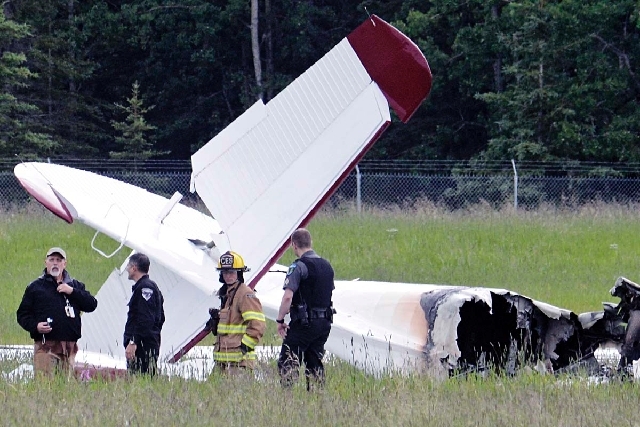Alaska crash victims thought to be from S Carolina

ANCHORAGE, Alaska — An air taxi that crashed and burned at a small Alaska airport, killing all 10 people onboard, was believed to be carrying nine passengers from South Carolina to a fishing lodge, authorities said Monday.
The victims also included the pilot of the de Havilland DHC3 Otter that went down shortly after 11 a.m. Sunday at the airport in Soldotna, about 75 miles southwest of Anchorage on the Kenai Peninsula, authorities said.
The Federal Aviation Administration said the Otter was operated by Rediske Air, based in Nikiski, another Kenai Peninsula community. The pilot of the downed plane was Nikiski-based Walter “Willie” Rediske, company spokesman Andy Harcombe said.
The remains of the victims were sent to the State Medical Examiner’s Office in Anchorage for autopsies and positive identifications. The South Carolina hometowns of those on board were not yet being released, Soldotna police Officer Mark Berestoff said.
“As soon as we can confirm it, we will release what we have,” he said.
Preliminary reports indicated the plane crashed after departure, National Transportation Safety Board investigator Clint Johnson said. The plane apparently was heading to a fishing lodge, but the name of the lodge was not immediately known, he said.
The NTSB was sending an investigative team from Washington that was expected to arrive on Monday. Also taking part will be Alaska-based investigator Brice Banning, who was called back from the Asiana Airlines crash site in San Francisco.
There were light winds and high clouds at the time of the Alaska crash, Johnson said.
“The weather at this point is obviously still on the table, but it’s not something we’re centering on,” he said. NTSB investigations also look at pilot error and mechanical problems as possible causes.
Rediske Air was involved in an accident last year in Nikiski, according to an NTSB database report.
In the non-injury mishap, the pilot of a Cessna 207A plane misidentified the runway surface at night and landed the aircraft in a snow bank. The pilot said most of the runway lights had been covered by heavy snow and were not clearly visible.
The plane’s wings and horizontal stabilizer sustained substantial damage.
Firefighters from Central Emergency Services were the first on the scene of Sunday’s crash, Capt. Lesley Quelland told the Anchorage Daily News (http://bit.ly/10IzzQN ).
She said they found the plane off the side of the runway, engulfed in flames. A big, black cloud of smoke was visible from the emergency services station, about three driving miles from the airport.
Authorities said the flames took 10 minutes to extinguish and initially kept firefighters from reaching the wreckage.
The de Havilland is similar to an Otter that crashed in Alaska in 2010, killing former U.S. Sen. Ted Stevens and four others, Johnson said. The plane in the Stevens crash was equipped with floats, while the plane in Sunday’s crash had wheels.
Flying in Alaska is common because of the limited road system in the vast state, where planes can encounter such hazards as volatile weather and treacherous mountain passes.
It’s possible to drive from Anchorage to Soldotna, but it’s about a four-hour trip as the highway hugs Turnagain Arm then cuts through a mountain pass.
Soldotna, with a population of about 4,300, is on the banks of the Kenai River, and the area is busy this time of the year with people fishing for salmon. The airport is located about a mile from a commercial area and has a paved runway that is 5,000 feet long.
Alaska has seen several plane crashes this year, including a June 28 crash that killed a pilot and two passengers on a commercial tour in the Alaska Range. The passengers in that crash also were from South Carolina.
In another crash Saturday, two men had to swim to shore after their plane went down in the waters off Kodiak Island. The small plane crashed after its engine sputtered out, and the men swam about 50 yards, the Kodiak Daily Mirror reported.
———
AP writer Mark Thiessen contributed to this report.